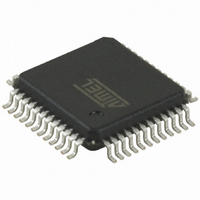AT32UC3B1128-AUT Atmel, AT32UC3B1128-AUT Datasheet - Page 317

AT32UC3B1128-AUT
Manufacturer Part Number
AT32UC3B1128-AUT
Description
IC MCU AVR32 128KB FLASH 48-TQFP
Manufacturer
Atmel
Series
AVR®32 UC3r
Specifications of AT32UC3B1128-AUT
Core Processor
AVR
Core Size
32-Bit
Speed
60MHz
Connectivity
I²C, IrDA, SPI, SSC, UART/USART, USB
Peripherals
Brown-out Detect/Reset, DMA, POR, PWM, WDT
Number Of I /o
28
Program Memory Size
128KB (128K x 8)
Program Memory Type
FLASH
Ram Size
32K x 8
Voltage - Supply (vcc/vdd)
1.65 V ~ 1.95 V
Data Converters
A/D 6x10b
Oscillator Type
Internal
Operating Temperature
-40°C ~ 85°C
Package / Case
48-TQFP, 48-VQFP
Package
48TQFP
Device Core
AVR32
Family Name
AT32
Maximum Speed
60 MHz
Operating Supply Voltage
1.8|3.3 V
Data Bus Width
32 Bit
Number Of Programmable I/os
28
Interface Type
I2S/SPI/TWI/USART/USB
On-chip Adc
6-chx10-bit
Number Of Timers
3
For Use With
ATSTK600-TQFP48 - STK600 SOCKET/ADAPTER 48-TQFPATAVRONEKIT - KIT AVR/AVR32 DEBUGGER/PROGRMMR770-1008 - ISP 4PORT ATMEL AVR32 MCU SPIATEVK1101 - KIT DEV/EVAL FOR AVR32 AT32UC3B
Lead Free Status / RoHS Status
Lead free / RoHS Compliant
Eeprom Size
-
Available stocks
Company
Part Number
Manufacturer
Quantity
Price
- Current page: 317 of 692
- Download datasheet (11Mb)
21.6.3.9
21.6.3.10
32059K–03/2011
Multidrop Mode
Transmitter Timeguard
Figure 21-21. Parity Error
If the PAR field in the Mode Register (MR) is programmed to the value 0x6 or 0x07, the USART
runs in Multidrop Mode. This mode differentiates the data characters and the address charac-
ters. Data is transmitted with the parity bit at 0 and addresses are transmitted with the parity bit
at 1.
If the USART is configured in multidrop mode, the receiver sets the PARE parity error bit when
the parity bit is high and the transmitter is able to send a character with the parity bit high when
the Control Register is written with the SENDA bit at 1.
To handle parity error, the PARE bit is cleared when the Control Register is written with the bit
RSTSTA at 1.
The transmitter sends an address byte (parity bit set) when SENDA is written to CR. In this case,
the next byte written to THR is transmitted as an address. Any character written in THR without
having written the command SENDA is transmitted normally with the parity at 0.
The timeguard feature enables the USART interface with slow remote devices.
The timeguard function enables the transmitter to insert an idle state on the TXD line between
two characters. This idle state actually acts as a long stop bit.
The duration of the idle state is programmed in the TG field of the Transmitter Timeguard Regis-
ter (TTGR). When this field is programmed at zero no timeguard is generated. Otherwise, the
transmitter holds a high level on TXD after each transmitted byte during the number of bit peri-
ods programmed in TG in addition to the number of stop bits.
As illustrated in
the programming of a timeguard. TXRDY rises only when the start bit of the next character is
sent, and thus remains at 0 during the timeguard transmission if a character has been written in
THR. TXEMPTY remains low until the timeguard transmission is completed as the timeguard is
part of the current character being transmitted.
Baud Rate
RXRDY
Figure
PARE
Clock
Write
RXD
CR
21-22, the behavior of TXRDY and TXEMPTY status bits is modified by
Start
Bit
D0
D1
D2
D3
D4
D5
D6
D7
Parity
Bad
Bit
Stop
Bit
RSTSTA = 1
AT32UC3B
317
Related parts for AT32UC3B1128-AUT
Image
Part Number
Description
Manufacturer
Datasheet
Request
R

Part Number:
Description:
DEV KIT FOR AVR/AVR32
Manufacturer:
Atmel
Datasheet:

Part Number:
Description:
INTERVAL AND WIPE/WASH WIPER CONTROL IC WITH DELAY
Manufacturer:
ATMEL Corporation
Datasheet:

Part Number:
Description:
Low-Voltage Voice-Switched IC for Hands-Free Operation
Manufacturer:
ATMEL Corporation
Datasheet:

Part Number:
Description:
MONOLITHIC INTEGRATED FEATUREPHONE CIRCUIT
Manufacturer:
ATMEL Corporation
Datasheet:

Part Number:
Description:
AM-FM Receiver IC U4255BM-M
Manufacturer:
ATMEL Corporation
Datasheet:

Part Number:
Description:
Monolithic Integrated Feature Phone Circuit
Manufacturer:
ATMEL Corporation
Datasheet:

Part Number:
Description:
Multistandard Video-IF and Quasi Parallel Sound Processing
Manufacturer:
ATMEL Corporation
Datasheet:

Part Number:
Description:
High-performance EE PLD
Manufacturer:
ATMEL Corporation
Datasheet:

Part Number:
Description:
8-bit Flash Microcontroller
Manufacturer:
ATMEL Corporation
Datasheet:

Part Number:
Description:
2-Wire Serial EEPROM
Manufacturer:
ATMEL Corporation
Datasheet:











